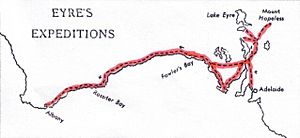Edward John Eyre facts for kids
Quick facts for kids
Edward John Eyre
|
|
|---|---|
 |
|
| Governor of Jamaica | |
| In office 1862–1865 |
|
| Monarch | Victoria |
| Preceded by | Charles Henry Darling |
| Succeeded by | Henry Knight Storks |
| Lieutenant-Governor of New Munster, New Zealand | |
| In office 1848–1853 |
|
| Governor | George Grey |
| Preceded by | None, position established |
| Succeeded by | None, position abolished |
| Personal details | |
| Born | 5 August 1815 Whipsnade, England, UK |
| Died | 30 November 1901 (aged 86) Devon, England, UK |
| Occupation | Explorer of Australia, Colonial Administrator, Grazier |
Edward John Eyre (born August 5, 1815 – died November 30, 1901) was an English explorer. He explored parts of Australia and later became a colonial administrator. He is well-known for his time as Governor of Jamaica, which caused a lot of debate.
Contents
Early Life and Adventures
Edward Eyre was born in Whipsnade, England. His family soon moved to Hornsea, where he grew up. Instead of joining the army or going to university, he decided to move to Sydney, Australia.
He quickly learned about life in this new land. He became friends with important people. Before his 18th birthday, he bought 400 lambs and became a flock owner.
Exploring South Australia
In December 1837, Eyre began a big journey. He was moving 1,000 sheep and 600 cattle overland. He started in Monaro, New South Wales and headed to Adelaide, South Australia.
Eyre and his eight stockmen arrived in Adelaide in July 1838. He sold his animals for a lot of money.
With his earnings, Eyre decided to explore the inner parts of South Australia. In 1839, he went on two separate trips. He explored north to the Flinders Ranges and west past Ceduna, South Australia. A mountain called Mount Eyre was named after him.
In 1840, Eyre went on another expedition. He reached a large lake. This lake was later named Lake Eyre in his honor.
Journey Across Australia
Edward Eyre made history with his Aboriginal companion, Wylie. They were the first Europeans to travel along the coast of the Great Australian Bight. This journey also crossed the Nullarbor Plain by land.
Their trip was almost 2,000 miles long. It took place from 1840 to 1841, ending in Albany, Western Australia. Eyre had started the expedition with John Baxter and three Aboriginal people.
On April 29, 1841, two of the Aboriginal companions killed Baxter. They also took most of the group's supplies. Eyre and Wylie were left with very little. They were lucky to find a French whaling ship, the Mississippi. It was led by an English captain, Thomas Rossiter. Eyre named the place where they met Rossiter Bay after him. In 1845, Eyre returned to England. He wrote a book about his amazing travels.
Becoming a Colonial Governor
From 1848 to 1853, Eyre worked as Lieutenant-Governor. He was in charge of New Munster Province in New Zealand. He worked under Sir George Grey.
In 1850, he married Miss Adelaide Ormond. Her brother, John Davies Ormond, was a politician.
Governor in Jamaica
Starting in 1854, Eyre became Governor of several Caribbean islands. These included Saint Vincent and Antigua.
Later, he became the Governor of Jamaica. In 1865, a serious event happened. It was called the Morant Bay rebellion. A Baptist preacher named Paul Bogle led this uprising. Eyre was worried about a bigger rebellion across the island. He took strong actions to stop it.
During this time, many people were killed or hurt. About 1,000 houses were burned down. Eyre also ordered the execution of George William Gordon. Gordon was a mixed-race member of the local assembly. He had spoken out against Eyre's rule. Even though Gordon was not directly involved in the rebellion, he was tried and hanged. Paul Bogle was also hanged a few days later.
Many European people in Jamaica saw Eyre as a hero. They believed he had saved the island from disaster. Eyre convinced the local government to change how Jamaica was ruled. It became a Crown Colony. This meant the British government had more direct control. This change also reduced the power of elected local leaders.
These events caused a huge debate in Britain. Some people, like John Stuart Mill, believed Eyre should be held responsible. They formed a group called the Jamaica Committee. This group included famous thinkers like Charles Darwin and Thomas Henry Huxley.
However, others supported Eyre. Thomas Carlyle started the Governor Eyre Defence and Aid Committee. This group argued that Eyre had acted quickly to bring back order. Famous supporters included Charles Dickens and Alfred, Lord Tennyson.
There were many legal challenges against Eyre. However, after several court cases, he was cleared of any wrongdoing. The legal system decided he had acted within the law at the time.
Later Life
The British government paid for Eyre's legal costs in 1872. In 1874, he received a pension as a retired colonial governor. He spent the rest of his life at Walreddon Manor in England. He passed away on November 30, 1901. He is buried in the churchyard at Whitchurch.
Recognition and Legacy
Edward Eyre is remembered in many ways. A statue of him stands in Victoria Square, Adelaide in Australia. In 1970, a postage stamp in Australia featured his portrait.
Many places in Australia are named after him. These include Lake Eyre, the Eyre Peninsula, Eyre Creek, and the Eyre Highway. There is also the Edward John Eyre High School. In New Zealand, places like Eyreton and the Eyre Mountains are named after him.
See also
 In Spanish: Edward John Eyre para niños
In Spanish: Edward John Eyre para niños



